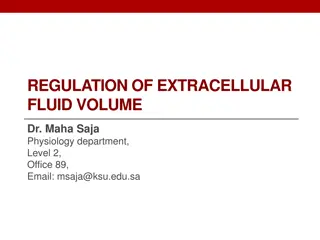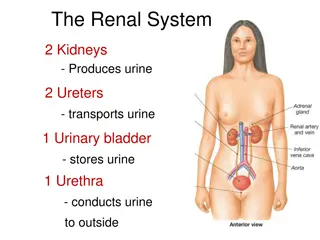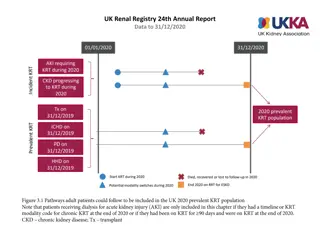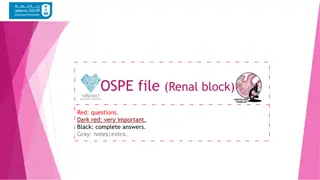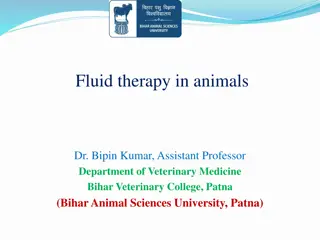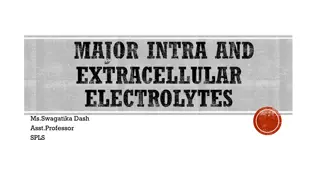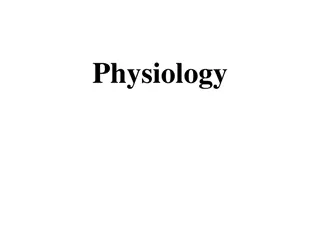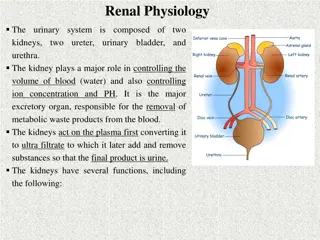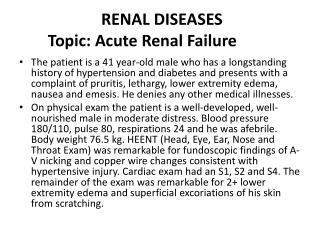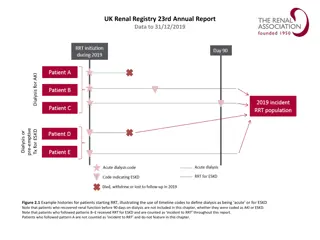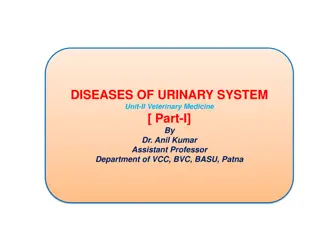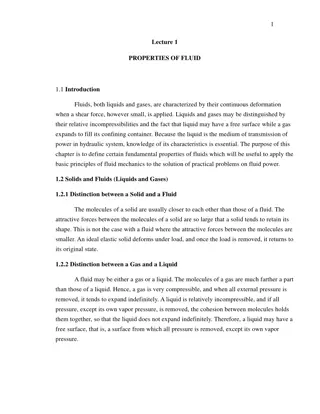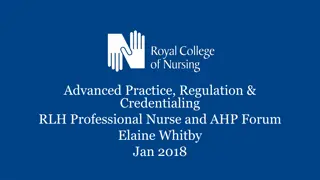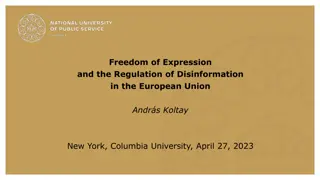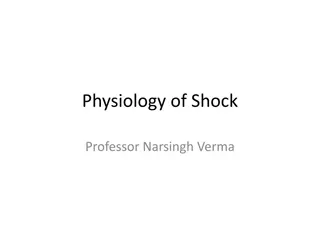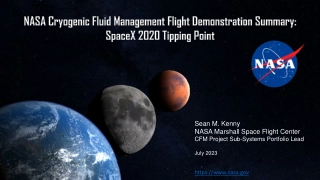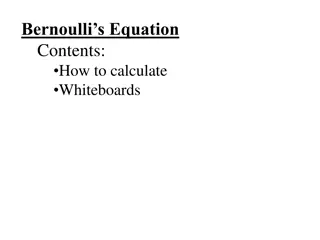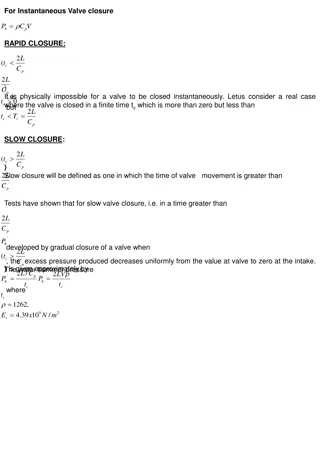Regulation of Extracellular Fluid Volume in Renal Physiology
This lecture focuses on the mechanisms involved in the regulation of extracellular fluid volume, primarily highlighting the role of sensors, effectors, and the kidney in maintaining body fluid balance. It discusses the importance of regulating extracellular fluid volume and osmolarity for controlling blood pressure, tissue perfusion, and cell function. The key role of sodium (Na+) in determining ECF volume is explained, along with factors influencing Na+ balance in the body.
Download Presentation

Please find below an Image/Link to download the presentation.
The content on the website is provided AS IS for your information and personal use only. It may not be sold, licensed, or shared on other websites without obtaining consent from the author. Download presentation by click this link. If you encounter any issues during the download, it is possible that the publisher has removed the file from their server.
E N D
Presentation Transcript
REGULATION OF EXTRACELLULAR FLUID VOLUME Dr. Maha Saja Physiology department, Email: msaja@ksu.edu.sa
Objectives Identify and describe the role of the sensors and effectors in the renal regulation of body fluid volume. Describe the role of the kidney in regulation of body fluid volume. Identify the site and describe the influence of aldosterone on reabsorption of Na+in the late distal tubules.
Introduction Regulation of ECF Control of ECF osmolarity Control of ECF volume Why is it important to regulate ECF volume & osmolarity? Determines; Affect; blood pressure tissue perfusion Cell volume cell function
Introduction Regulation of ECF ECF volume is regulated by ECF osmolarity is regulated by The two systems use different; Sensors Hormonal transducers Effectors Adjusting total body watercontent Adjusting total body Na+ content This is the focus of this lecture This was discussed in the last lecture WaterExcretion Na+ Excretion urine
Why does the body regulate ECF volume by adjusting body Na+ content??
Electrolyte Composition of Body Fluids ECF The main osmotic constituents of ECF
ECF Volume The most abundant cation in ECF is Na+ The most abundant anions in ECF are Cl- and HCO3- The body regulates ECF volume by monitoring and adjusting total body content of Na+ ECF volume is closely linked to Na+ balance How??
Why is Na+ Content the Main Determinant of ECF Volume? [Na+] in ECF Na+ and its associated anions are the main osmotic constituents of ECF volume. When Na+ salts move, water must follow. ECF osmolarity H2O reabsorption by kidney and stimulate thirst Increases ECF volume
Sodium Balance Input Output Dietary intake; RDA = 1.5-2.3 g/day Actual content in western diet = 7g/day Kidney (most important). Minor pathways under normal conditions GI loss Sweat (Preston & Wilson. Lippincott s illustrated reviews Physiology)
Sodium Distribution in the Body Body sodium distribution ECF (65%) ICF Bones (25-30%) (5-10%) As Na+ apatite salts Exchangeable (Boron & Boulpaep. Medical Physiology)
ECF VOLUME REGULATION
ECF Volume Regulation What does the body sense? What are the sensors? How does it execute its action? What are the effectors?
What Does the Body Sense? The body does not sense ECF volume per se! But it senses Effective circulating volume (ECV). Effective circulating volume (ECV) = a functional blood volume that reflects the extent of tissue perfusion in specific regions, as evidenced by the pressure in their blood vessels. In short, ECV reflects adequacy of circulation. Fullness and pressure in the vessels. Usually changes in ECV parallel those of ECF volume. (Boron & Boulpaep. Medical Physiology)
Effective Circulating Volume Normal ECF volume Decrease in ECF volume Increase in ECF volume Decrease in ECV Normal ECV Increase in ECV Decrease in tissue perfusion Normal ABP and Adequate tissue perfusion Increase in ABP & tissue perfusion
What are the Sensors? Changes in ECV are sensed by baroreceptors. Low-pressure baroreceptors. High-pressure baroreceptors. (Boron & Boulpaep. Medical Physiology)
What are the Effectors? Change in ECV (ECF volume) Affects ECV sensors Baroreceptors This generates 4 distinct hormonal/neural pathways Sympathetic NS RAAS ADH ANP
The Renin-Angiotensin-Aldosterone System (RAAS) ECV stretch of baroreceptors in the afferent arteriole Causes granular cells to release Renin ACE Renin Angiotensinogen Angiotensin-I Angiotensin-II ADH Aldosterone Vasoconstrictor reabsorption of Na+ from tubule Na+ excretion (Boron & Boulpaep. Medical Physiology)
The Renin-Angiotensin-Aldosterone System (RAAS) ABP [NaCl] at macula densa renal perfusion pressure (Boron & Boulpaep. Medical Physiology)
Sympathetic Nervous System (SNS) Its role is thought to be especially important during stressful conditions, e.g. hemorrhage. Stimulates SNS ECV Direct Indirect Renal vascular resistance Stimulate renin release Na+ reabsorption
Atrial Natriuretic Peptide (ANP) ANP promotes natriuresis (Na+ excretion). Secreted by atrial myocytes in response to stretch. ECV ANP release Na+ excretion
Antidiuretic Hormone (ADH) Large in ECV ADH (AVP)
Final Note Although, under physiologic conditions, the body regulates plasma volume & plasma osmolarity independently. Severe derangements in fluid & electrolyte balance may challenge the system by presenting two conflicting changes in osmolarity and volume. In general, the body defends volume at the expense of osmolarity.


